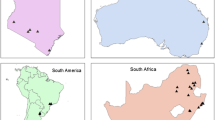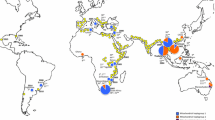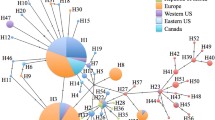Abstract
The Asian long-horned beetle (ALB), a Cerambycidae, is an urban tree pest native to East Asia accidentally introduced to other continents via solid wood packing material. It was first detected in Europe in 2001, and since then infestations have been found in ten European countries. Using a 485-bp-long fragment of the mitochondrial barcode gene (COI), we studied the genetic diversity and structure of ALB populations in both native and invaded ranges, with a specific focus on Europe. Three main haplotypes were found across the native and invaded distribution of ALB. The native area in Asia was the most diverse with 23 haplotypes, but a low genetic structure was observed. Our results revealed up to nine distinct haplotypes that was diverged by no more than six mutational steps in European populations collected from 2001 to 2016. Nevertheless, the genetic structure was characterized by one widespread dominant haplotype in Europe. The overall complex genetic structure observed in Europe suggested a convoluted invasion scenario. Indeed, invasion history may include several introduction events as well as secondary dispersal.





Similar content being viewed by others
Change history
15 November 2017
In Table 1, longitude of the population 1 (Tallgrass, Canada) and the associated Figs. <InternalRef RefID="Fig1">2</InternalRef>c and <InternalRef RefID="Fig2">5</InternalRef>c were published incorrectly in the original publication of the article.
References
Allendorf FW, Lundquist LL (2003) Introduction: population biology, evolution, and control of invasive species. Conserv Biol 17:24–30
An YL, Wang BD, Yang XJ, Lin XJ, Chen JD, Huang XM, Mastro V (2004) Characterizing populations of Anoplophora glabripennis and related taxa with RAPD. Acta Entomol Sin 47:229–235
Auger-Rozenberg M-A, Boivin T, Magnoux E, Courtin C, Roques A, Kerdelhué C (2012) Inferences on population history of a seed chalcid wasp: invasion success despite a severe founder effect from an unexpected source population. Mol Ecol 21:6086–6103
Aukema JE, McCullough DG, Von Holle B, Liebhold AM, Britton K, Frankel SJ (2010) Historical accumulation of nonindigenous forest pests in the continental United States. Bioscience 60:886–897
Bartell SM, Nair SK (2003) Establishment risks for invasive species. Risk Anal 24:833–845
Carter M, Casa AM, Zeid M, Mitchell SE, Kresovich S (2008) Isolation and characterization of microsatellite loci for the Asian longhorned beetle, Anoplophora glabripennis. Perm Genet Resour 9:925–928
Carter ME, Smith MT, Harrison RG (2009) Patterns of genetic variation among populations of the Asian longhorned beetle (Coleoptera: Cerambycidae) in China and Korea. An Entomol Soc Am 102:895–905
Carter ME, Smith MT, Harrison R (2010) Genetic analyses of the Asian longhorned beetle (Coleoptera, Cerambycidae, Anoplophora glabripennis), in North America, Europe and Asia. Biol Invasions 12:1165–1182
Ciosi M, Miller NJ, Kim KS, Giordano R, Estoup A, Guillemaud T (2008) Invasion of Europe by the western corn rootworm, Diabrotica virgifera virgifera: multiple transatlantic introductions with various reductions of genetic diversity. Mol Ecol 17:3614–3627
De-la-Mora M, Piñero D, Núñez-Farfán J (2015) Phylogeography of specialist weevil Trichobaris soror: a seed predator of Datura stramonium. Genetica 143:681–691
Dlugosch KM, Parker IM (2008) Founding events in species invasions: Genetic variation, adaptive evolution, and the role of multiple introductions. Mol Ecol 17:431–449
Dodds KJ, Orwig DA (2011) An invasive urban forest pest invades natural environments—Asian longhorned beetle in northeastern US hardwood forests. Can J For Res 41:1729–1742
Downie DA (2002) Locating the sources of an invasive pest, grape phyloxera, using a mitochondrial DNA genealogy. Mol Ecol 11:2013–2026
Drag L, Hauck D, Bérces S, Michalcewicz J, Jelaska LSC, Aurenhammer S, Cizek L (2015) Genetic differentiation of populations of the threatened saproxylic beetle Rosalia longicorn, Rosalia alpina (Coleoptera: Cerambycidae) in Central and South-East Europe. Biol J Linn Soc 116:911–925
Eidg. Forschungsanstalt WSL (2014) WSL-Magazin Diagonal, 2/14. 36 S., ISSN 2296-3561
Essl F, Bacher S, Blackburn TM, Booy O, Brundu G, Brunel S, Cardoso A-C, Eschen R, Gallardo B, Galil B, García-Berthou E, Genovesi P, Groom Q, Harrower C, Hulme PE, Katsanevakis S, Kenis M, Kühn I, Kumschick S, Martinou AF, Nentwig W, O’Flynn C, Pagad S, Pergl J, Pyšek P, Rabitsch W, Richardson DM, Roques A, Roy HE, Scalera R, Schindler S, Seebens H, Vanderhoeven S, Vilà M, Wilson JRU, Zenetos A, Jeschke JM (2015) Crossing frontiers in tackling pathways of biological invasions. Bioscience 65:769–782
Estoup A, Guillemaud T (2010) Reconstructing routes of invasion using genetic data: why, how and so what? Mol Ecol 19:4113–4130
Estoup A, Ravigné V, Hufbauer R, Vitalis R, Gautier M, Facon B (2016) Is there a genetic paradox of biological invasion? Annu Rev Ecol Evol Syst 47:51–72
European and Mediterranean Plant Protection Organization (EPPO) Global Database. https://gd.eppo.int/taxon/ANOLGL/distribution. Accessed 24 Aug 2016
Excoffier L, Smouse P, Quattro J (1992) Analysis of molecular variance inferred from metric distances among DNA haplotypes: application to human mitochondrial DNA restriction data. Genetics 131:479–491
Excoffier L, Laval G, Schneider G (2005) Arlequin ver. 3.0: an integrated software package for population genetics data analysis. Evol. Bioinform. Online 1:47–50
Favaro R, Battisti A, Faccoli M (2013) Dating Anoplophora glabripennis introduction in North-East Italy by growth-ring analysis. J Entomol Acarol Res 45:35
Folmer O, Black M, Hoeh W, Lutz R, Vrijenhoek R (1994) DNA primers for amplification of mitochondrial cytochrome c oxidase subunit I from diverse metazoan invertebrates. Mol Mar Biol Biotech 3:294–299
Garnas JR, Auger-Rozenberg M-A, Roques A, Bertelsmeier C, Wingfield MJ, Saccaggi DL, Roy HE, Slippers B (2016) Complex patterns of global spread in invasive insects: eco-evolutionary and management consequences. Biol Invasions 18:935–952
Guillemaud T, Beaumont MA, Ciosi M, Cornuet J-M, Estoup A (2010) Inferring introduction routes of invasive species using approximate Bayesian computation on microsatellite data. Heredity 104:88–99
Haack RA, Cavey JF, Hoebeke ER, Law KL (1996) Anoplophora glabripennis: a new tree-infesting exotic cerambycid invades New York. Mich Entomol Soc Newsl 41:1–3
Haack RA, Hérard F, Sun J, Turgeon JJ (2010) Managing invasive populations of Asian longhorned beetle and citrus longhorned beetle: A worldwide perspective. Annu Rev Entomol 55:521–546
Haran J, Koutroumpa F, Magnoux E, Roques A, Roux G (2015) Ghost mtDNA haplotypes generated by fortuitous NUMTs can deeply disturb infra-specific genetic diversity and phylogeographic pattern. J Zool Syst Evol Res 53:109–115
Hérard F, Ciampitti M, Maspero M, Krehan H, Benker U, Boegel C, Schrage R, Bouhot-Delduc L, Bialooki P (2006) Anoplophora species in Europe: infestations and management processes. EPPO Bull 36:470–474
Hewitt G (2000) The genetic legacy of the Quaternary ice ages. Nature 405:907–913
Hu J, Angeli S, Schuetz S, Luo Y, Hajek AE (2009) Ecology and management of exotic and endemic Anoplophora glabripennis (Coleoptera: Cerambycidae). Agric For Entomol 11:359–375
Hulme PE (2009) Trade, transport and trouble: managing invasive species pathways in an era of globalization. J Appl Ecol 46:10–18
Hurley BP, Garnas J, Wingfield MJ, Branco M, Richardson DM, Slippers B (2016) Increasing numbers and intercontinental spread of invasive insects on eucalypts. Biol Invasions 18:921–933
Javal M, Roux G, Roques A, Sauvard D (2017) Asian long-horned beetle dispersal potential estimated in computer-linked flight mills. J Appl Entomol. doi:10.1111/jen.12408
Kerdelhué C, Boivin T, Burban C (2014) Contrasted invasion processes imprint the genetic structure of an invasive scale insect across southern Europe. Heredity 113:390–400
Li WH (2004) Degradation and restoration of forest eco- systems in China. For Ecol Manag 201:33–41
Librado P, Rozas J (2009) DnaSP v5: a software for comprehensive analysis of DNA polymorphism data. Bioinformatics 25:1451–1452
Lingafelter SW, Hoebeke ER (2002) Revision of Anoplophora (Coleoptera: Cerambycidae). Entomological Society of Washington, Washington
Lippens C, Estoup A, Hima MK, Loiseau A, Tatard C, Dalecky A, Bâ K, Kane M, Diallo M, Sow A, Niang Y, Berthier K, Leblois R, Duplantier J-M, Brouat C (2017) Genetic structure and invasion history of the house mouse (Mus musculus domesticus) in Senegal, West Africa: a legacy of colonial and contemporary times. Heredity 119:64–75
Lombaert E, Guillemaud T, Cornuet J-M, Malausa T, Facon B, Estoup A (2010) Bridgehead effect in the worldwide invasion of the biocontrol harlequin ladybird. PLoS ONE 5:e9743
Lopez VM, Hoddle MS, Francese JA, Lance DR, Ray AM (2017) Assessing flight potential of the invasive Asian longhorned beetle (Coleoptera: Cerambycidae) with computerized flight mills. J Econ Entomol 110:1070–1077
Lowe S, Browne M, Boudjelas S, De Poorter M (2000) 100 of the World’s Worst Invasive Alien Species: A Selection from the Global Invasive Species Database. Invasive Species Specialist Group of the Species Survival Commission (SSC) of the World Conservation Union (IUCN), Auckland, New Zealand
Meng PS, Hoover K, Keena M (2015) Asian longhorned beetle (Coleoptera: Cerambycidae), an introduced pest of maple and other hardwood trees in North America and Europe. J Integr Pest Manag 6:1–13
Nicholas KB, Nicholas HB Jr, Deerfield DW II (1997) GeneDoc: analysis and visualization of genetic variation. Embnew News 4:1–4
Normile D (2004) Invasive species. Expanding trade with China creates ecological backlash. Science 306:968–969
Pan HY (2005) Review of the Asian longhorned beetle: Research, Biology, Distribution and Management in China. Forestry Department. Working Paper FBS/6E, Food and Agriculture Organization of the United Nations, Rome (IT)
Pennacchio F, Peverieri GS, Jucker C, Allegro G, Roversi PF (2012) A key for the identification of the larvae of Anoplophora chinensis, Anoplophora glabripennis and Psacothea hilaris (Coleoptera Cerambycidae Lamiinae) in Europe. Redia 95:57–65
Petit RJ, El Mousadik A, Pons O (1998) Identifying populations for conservation on the basis of genetic markers. Conserv Biol 12:844–855
Pudlo P, Marin J-M, Estoup A, Cornuet J-M, Gautier M, Robert CP (2015) Reliable ABC model choice via random forests. Bioinformatics 32:859–866
Ramsfield TD, Bentz B, Faccoli M, Jactel H, Brockerhoff EG (2016) Forest health in a changing world: effects of globalization and climate change on forest insect and pathogen impacts. For Int J For Res 89:245–252
Rius M, Darling JA (2014) How important is intraspecific genetic admixture to the success of colonising populations? Trends Ecol Evol 29:233–242
Roderick GK, Navajas M (2003) Genes in new environments: Genetics and evolution in biological control. Nat Rev Genet 4:889–899
Roman J, Darling JA (2007) Paradox lost: genetic diversity and the success of aquatic invasions. Trends Ecol Evol 22:454–464
Roques A (2010) Taxonomy, time and geographic patterns. Chapter 2. In: Roques A et al. (eds) Alien terrestrial arthropods of Europe. BioRisk, Vol 4, pp 11–26
Roques A, Auger-Rozenberg M-A, Blackburn TM, Garnas J, Pyšek P, Rabitsch W, Richardson DM, Wingfield MJ, Liebhold AM, Duncan RP (2016) Temporal and interspecific variation in rates of spread for insect species invading Europe during the last 200 years. Biol Invasions 18:907–920
Sawyer A (2009) Expected dispersal of Asian longhorned beetles from preferred host trees as a function of infestation level and data of removal during the flight season. Report from the USDA APHIS PPQ Otis Laboratory to the ALB Technical Working Group
Smith MT, Bancroft J, Li G, Gao R, Teale S (2001) Dispersal of Anoplophora glabripennis (Cerambycidae). Environ Entomol 30:1036–1040
Smith MT, Tobin PC, Bancroft J, Li G, Gao R (2004) Dispersal and spatiotemporal dynamics of Asian longhorned beetle (Coleoptera: Cerambycidae) in China. Environ Entomol 33:435–442
Smith M, Turgeon J, De Groot P, Gasman B (2009) Asian longhorned beetle Anoplophora glabripennis (Motschulsky): lessons learned and opportunities to improve the process of eradication and management. Am Entomol 55:21–25
Song H, Buhay JE, Whiting MF, Crandall KA (2008) Many species in one: DNA barcoding overestimates the number of species when nuclear mitochondrial pseudogenes are coamplified. Proc Natl Acad Sci USA 105:13486–13491
Suarez AV, Tsutsui ND, Holway DA, Case TJ (1999) Behavioral and genetic differentiation between native and introduced populations of the Argentine ant. Biol Invasions 1:43–53
Trotter RT, Hull-Sanders HM (2015) Quantifying Dispersal of the Asian longhorned beetle (Anoplophora glabripennis, Coleoptera) with incomplete data and behavioral knowledge. Biol Invasions 17:3359–3369
Turgeon JJ, Orr M, Grant C, Wu Y, Gasman B (2015) Decade-Old Satellite infestation of Anoplophora glabripennis Motschulsky (Coleoptera: Cerambycidae) found in Ontario, Canada outside regulated area of founder population. Coleopt Bull 69:674–678
Walther G, Roques A, Hulme PE, Sykes MT, Pyšek P, Kühn I, Zobel M, Bacher S, Botta-Dukat Z, Bugmann H, Czucz B, Dauber J, Hickler T, Jarošik V, Kenis M, Klotz S, Minchin D, Moora M, Nentwig W, Ott J, Panov VE, Reineking B, Robinet C, Semenchenko V, Solarz W, Thuiller W, Vilà M, Vohland K, Settele J (2009) Alien species in a warmer world: risks and opportunities. Trends Ecol Evol 24:686–693
Williams DW, Lee HP, Kim IK (2004a) Distribution and abundance of Anoplophora glabripennis (Coleoptera: Cerambycidae) in natural Acer stands in South Korea. Environ Entomol 33:540–545
Williams DW, Li G, Gao R (2004b) Tracking movements of individual Anoplophora glabripennis (Coleoptera: Cerambycidae) adults: application of harmonic radar. Environ Entomol 33:644–649
Yang XM, Sun JT, Xue XF, Li JB, Hong XY (2012) Invasion genetics of the western flower thrips in China: evidence for genetic bottleneck, hybridization and bridgehead effect. PLoS ONE 7:e34567
Acknowledgements
We are grateful to Marie-Claude Bon and Lincoln Smith for comments on the manuscript, and we thank Camille Bagnis, Brigitte Delahaye-Panchout, Christine Daviet, Massimo Faccoli, Jianting Fan, Gernot Hoch, Stephan Koenig, Raphaelle Moutet, Simone Prospero, Rémi Rossignol, Jing Tao, Jean Turgeon, Beat Wermelinger, Jake Wickham and Shixiang Zong for providing information and samples for analysis. We greatfully acknowledge financial support from the French Ministry of Agriculture, Food, and Forestry (Convention DGAL E07/2014 “Estimation de l’impact écologique du Capricorne Asiatique Anoplophora glabripennis sur les populations xylophages natives et leurs organismes associés, et traçage génétique de l’origine de ses populations invasives en France continentale et en Corse”), and from the Région Centre Val de Loire. We also thank three anonymous reviewers for helpful comments on the manuscript.
Author information
Authors and Affiliations
Corresponding author
Ethics declarations
Conflict of interests
None of the authors declare conflict of interest for the present study. Specimens sampled did not involve endangered nor protected species.
Additional information
Communicated by J. D. Sweeney.
Special issue on “Invasive insect pests of forests and urban trees: pathways, early detection and management”.
Electronic supplementary material
Below is the link to the electronic supplementary material.
Rights and permissions
About this article
Cite this article
Javal, M., Roques, A., Haran, J. et al. Complex invasion history of the Asian long-horned beetle: fifteen years after first detection in Europe. J Pest Sci 92, 173–187 (2019). https://doi.org/10.1007/s10340-017-0917-1
Received:
Revised:
Accepted:
Published:
Issue Date:
DOI: https://doi.org/10.1007/s10340-017-0917-1




